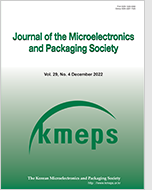
Search
- Past Issues
- e-Submission
-

KCI Accredited Journals KCI 등재지
KCI Impact Factor 0.54
Editorial Office
- +82-2-538-0962
- +82-2-538-0963
- kmeps@kmeps.or.kr
- http://kmeps.or.kr/

KCI Accredited Journals KCI 등재지
KCI Impact Factor 0.54
Journal of the Microelectronics and Packaging Society 2024;31(4):18-28. Published online: Jan, 22, 2025
DOI : doi.org/10.6117/kmeps.2024.31.4.018
The demand for power modules and next-generation WBG power semiconductors is surging owing to the growth of the electric vehicle market and the expansion of renewable energy. In particular, SiC power semiconductors require high-temperature die-attach materials to ensure thermal reliability, necessitating the development of Ag or Cu-based sinterbonding materials as alternatives to conventional solder. Compared to pressure-assisted processes, pressureless processes have significant industrial potential, however issues such as long processing times and low joint density must be addressed. Therefore, this paper reviews previously reported pressureless sinter-bonding methods for Ag and Cu fillers, categorizing them into chemical approaches, particle optimization, and other improvement methods. We analyze and compare the results and characteristics of these studies. The use of Ag nanoparticles in pressureless sinter-bonding has demonstrated rapid joint strength and dense joint formation based on accumulated research, suggesting high potential for future mass production applications. On the other hand, Cu-based pressureless sinter-bonding is still in its early research stages, however recent results showing successful sintering of ultrafine Cu nanoparticles in a nitrogen atmosphere indicate promising progress, suggesting that the development of Cu-based pressureless sinter-bonding technology will continue to advance actively
Keywords Power module, WBG semiconductor, SiC, Die-attach, Pressureless sinter-bonding, Nanoparticle